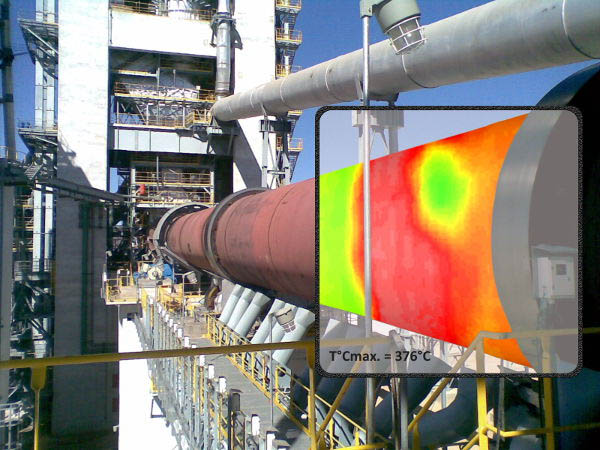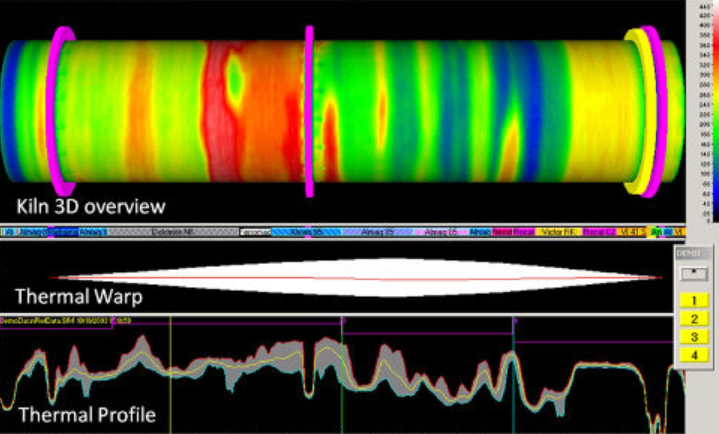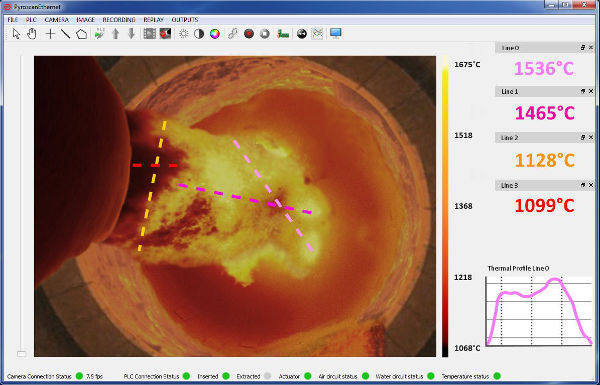As temperature plays an essential part in the formation of clinker, thermal measurements are key data points to be monitored in the cement plant control room. Today’s high-end thermal scanners and cameras provide the cement industry with accurate and continuous surveillance of kiln shell temperature.
For many cement plant managers, there is no doubt that the accurate thermal monitoring of the pyroprocessing line is a necessary investment, generating profit by contributing to an improved product quality, the reduction of operating and maintenance costs, and the optimization of energy use. Thermal scanners and cameras enable such continuous surveillance of the kiln shell temperature and therefore have a central position in the control room of hundreds of modern cement plants around the world.
At the core of the sintering process, the kiln shell is a long cylinder made of steel, with a typical length ranging between 60-100m and weighing around 1000t. Despite this impressive mass, the kiln shell is a giant with feet of clay, exposed to harsh environmental conditions. The inner part of the kiln is heated on one side by a flame to 2000˚C. The internal temperature, at the other side, is around 900˚C, while the outer layer of the shell can have to support a temperature of -10˚C during cold winters. These strong temperature gradients induce important mechanical stresses on the kiln shell, with possible dramatic consequences on the refractory lining strength. Refractory bricks protect the kiln shell from overheating, as shell materials start to weaken at temperatures above 500˚C. Therefore, early detection of hotspots on the kiln shell, resulting from a refractory failure, is critical to quickly take preventive action and avoid costly maintenance and unplanned shutdowns.

To ensure this early detection of hotspots, cement plants must continuously monitor, preferably at high resolution, the entire surface of the shell with the help of thermal imaging technology. The Kilnscan temperature scanner from EOI has been developed to alert of any single refractory brick weakness, thanks to its high spatial resolution. The spatial resolution is the smallest spot size on the kiln shell where the scanner can perform an accurate temperature measurement. It is an important parameter differentiating a good thermal scanner from a poor one. For maximum efficiency, the spatial resolution must be small enough to detect the fall of a single brick or part of it. Depending on the optics quality, the sampling spot dimension differs greatly between scanners on the market. Scanners with a low resolution can give a late warning, due to averaging on the thermal map, which smooths temperature peaks. As a result, the alarm thresholds cannot be reached sufficiently in advance for the kiln shell distortion to be avoided.
With a single-brick resolution, the Kilnscan high-end thermal scanner identifies such issues at the earliest opportunity, allowing rapid and efficient action to re-build the coating (such as locally cooling down the shell with fans or modifying the burner settings). This corrective action can prevent kiln shutdown and its inherent consequences, which include loss of production, costly repairs, and weakness of cooled down brick lining due to thermal shock.

The thermal resolution is a characteristic coupled to the spot size. Combined with spatial resolution, it guarantees sharp and precise image display. Kilnscan has a resolution below 0.1˚C, ensuring that any shade will be clearly reported on the thermal map. On a medium-term basis, the monitoring of the thermal data with a high resolution provides accurate information about the evolution of the coating thickness inside the kiln.
The coating is a layer of clinker or dust adhering to the refractory lining. It is necessary, as it lowers the shell temperature and protects the refractory material. Nevertheless, an unstable coating thickness can cause loss of energy and disturb clinker progression along the kiln. Kilnscan accurately monitors coating thickness and therefore, in case of deviation, allows staff to carry out preventative measures such as adjusting the combustion condition or the shell temperature with cooling fans. The excess accumulation of coating can lead to the formation of rings, mainly but not only in the sintering zone, which considerably reduces the internal diameter and, as a result, lowers production performance. Rings build up and block clinker flow, requiring a kiln stop and incurring high revenue losses. A single shutdown avoided by an accurate surveillance of the coating thickness inside the kiln completely justifies the investment in a high-end thermal scanner.
Kilnscan also offers a unique feature that contributes both in preserving equipment lifespan and production efficiency: the thermal warp computation. This function consists of calculating the kiln thermo-mechanical distortion induced by temperature changes over the shell, to infer the cyclical overloads and associated stresses suffered by the shell, tires and roller stations. The medium and long-term evolution of the thermal warp data provides information on the process development inside the kiln, including the development of coatings, kiln push of unburnt material and flame adjustment. It also can be a valuable indicator of mechanical and thermal stresses in the shell and the tires as well as of load fluctuation supported by each pier. Combined with tire slip monitoring, which is the measurement of the clearance between the kiln shell and its supporting tires, these data help in consolidating a plan for checking the shell geometry, the deviation in ovality, eccentricity, and misalignment.
The kiln shell thermal monitoring, provided by the Kilnscan scanner, can be complemented by the Pyroscan camera, installed close to the burner, with a borescope inserted in the firing zone.
Pyroscan is a MegaPixel Ethernet color camera, offering the highest resolution and dynamic range on the market. It provides an HD visualization of the flame pattern, along with a temperature measurement, over a large range from 700˚C to 1800˚C, for every pixel within the image. Thanks to robust dust filter algorithms, Pyroscan is able to operate through the challenging, cluttered burning zone environment. The reliable temperature reading and HD imagery help operators to stabilize the burning process, to homogenize and increase the clinker quality. Pyroscan efficiently monitors any changes in flame pattern and heat transfer to the product. It is a comprehensive tool for burner adjustment, particularly for firing alternative fuels, assisting the operator in adjusting burner to changing conditions, in monitoring air/fuel ratio, and in maintaining flame properties.
Beyond controlling combustion conditions, the Pyroscan also displays contrasted images of sinter or coal ash rings, which can form in the firing zone, as well as serious other coating build-ups, including ‘rhino horn’ on the burner pipe and boulders or ‘snowmen’ at cooler entry. Pyroscan can also be used to view the clinker fall in the cooler, measure clinker temperature, and detect red rivers.
The Pyroscan software enables the operator to remotely control the extraction and the insertion of the Pyroscan into the kiln, and provides accurate temperature measurements and contrasted imagery in the firing zone. Multiple measurement areas can be defined and alarms can be set in those areas. The software supports flame shape monitoring with user-defined analyzing lines. The temperature of the zones can be stored into a database and reviewed for further analysis. The software also includes an OPC client option for sharing data on the plant network as well as video streaming over IP.

EOI’s thermal scanner and camera make up a complete diagnostic tool, which not only shows hotspot formation on kiln surface just after the fall of a single refractory brick, but warns of potential risks sufficiently in advance to enable the necessary adjustments. With reliable and complete measurement of kiln shell condition, the risk of unexpected breakdowns and failures can be reduced. This results in enhanced equipment lifetime, and with process optimization, reduces operation costs. Compared with losses induced by unscheduled shutdowns, the return on the investment in thermal monitoring systems is really short.


